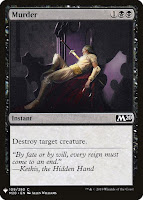As promised in the previous post, today I look at tweaked reprints. From yesterday,
- A strict reprint is reusing an existing card in a new release. It might have new art or flavor text, but the same name, casting cost, type (creature/instant/etc.), stats, and abilities- it's identical in every game-relevant aspect.
- A functional reprint is a card that has the same color, casting cost, type, stats, and abilities of an existing card but different name.
A tweaked reprint is a card that has similar casting cost, stats, and abilities of an existing card, but could be a different type or even color. But I'll stick with examples in the same color:
The first two cards, Reviving Dose and Revitalize, have identical stats but different casting cost. The second pair are nearly strict reprints save for card type (instant vs. sorcery) and a nuance: Healing Hands says "target player gains 4 life," while Ritual of Rejuvenation says "You gain 4 life." For the former, most of the time, I'd imagine you'd choose yourself as the target player, but it is an option to choose another.
Next example: destroying creatures.
This first set of cards has an identical ability but slightly varying casting cost- either in total amount of mana or color requirements: {3}{B} vs. {1}{B}{B} vs. {2}{B}{B}. And some are instants, some sorceries. But many variations on this card have been made over the years, adding abilities simplistically grouped as 'conditional' or 'additional.' Conditional first:
Note that these are cheaper than the generic 'destroy' options, but come with conditions based on creature type, power, or color. And some are instants, others sorceries. The next set is additional:
These cards are more expensive than the generic, because they both destroy a creature and grant some additional bonus- surveilling, discarding, creating a food token, or gaining life. And again, note instant vs. sorcery.
Why offer tweaked reprints?
- To account for the flavor of a set. Deadly Visit or Bake into a Pie are examples: their respective sets had keywords or tokens added to the generic ability. Surveil decks could make good use of the former; Food decks, the latter.
- To adjust spell cost or type based on the strengths/weaknesses of a set. If, for example, a set features many expensive creatures (like the Ixalan block), a card like Impale- which costs more than the standard Murder spell- reflects the designer's desire to scale the cost of removal spells accordingly. (People won't play those expensive dinosaurs if a cheap removal spell does them in.) Instant vs. sorcery makes a big different, too- I'll cover 'instant speed' another time.
- To balance standard or another format's metagame. If a certain color or strategy is gaining the upper hand in a format, Wizards might introduce a conditional card designed to curb the strategy's dominance without banning cards. Deathmark, for example, is a cheap spell clearly aimed at white/green decks. It may have been introduced to balance out the meta at the time (I don't know in this specific case, but have seen this done before).
- Like functional reprints, tweaked reprints can be a way to get more of a certain type of card into your deck. If you have a life gain/card draw deck, you might want four copies of both Reviving Dose and Revitalize, for example.
Learning to recognize reprints (of all stripes) helps players understand and navigate an impressively big card pool. With over 20,000 unique cards, even lifelong students of the game will come across cards they've never seen (or remember seeing) before. With the different types of reprints, players will learn to recognize trends and patterns across sets, becoming familiar with typical card abilities and the various ways they can be presented. You may even find yourself starting to think of new cards in terms of existing: "oh, that's like a more expensive _____." Ultimately, though this game has near-infinite variety, there is nothing new under the sun.
















No comments:
Post a Comment